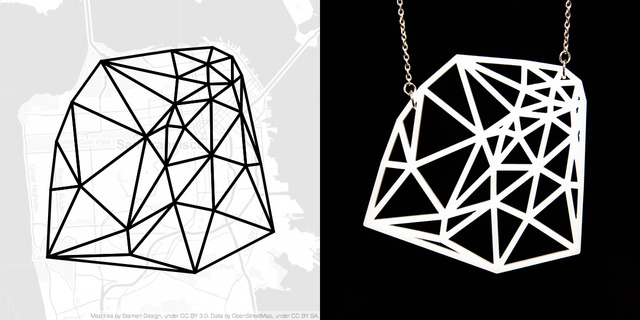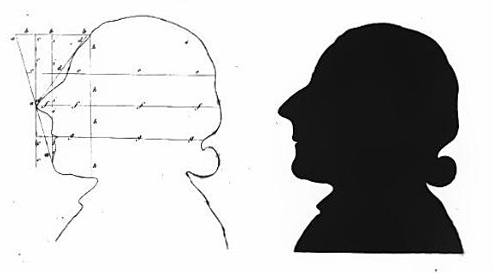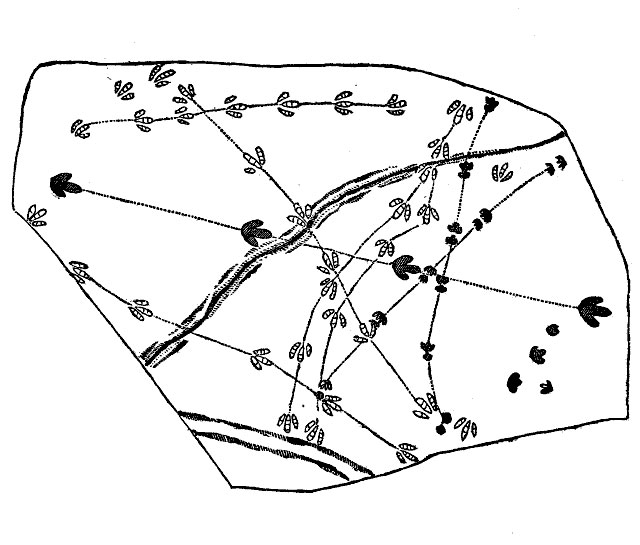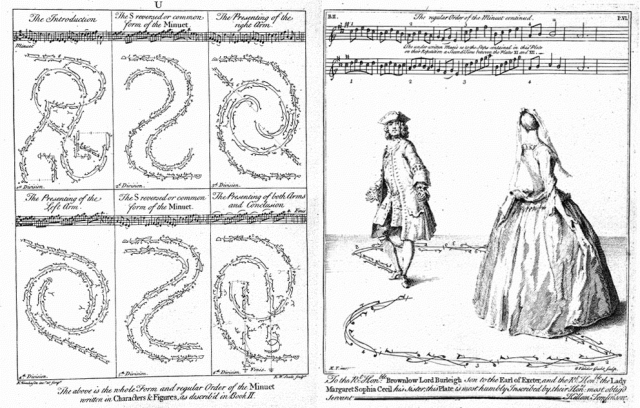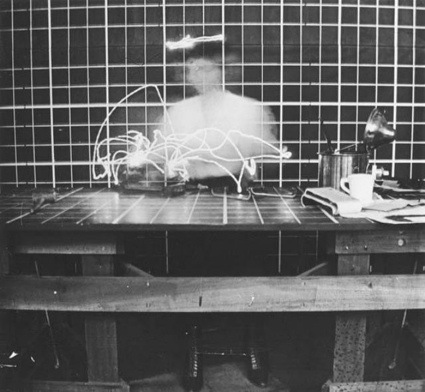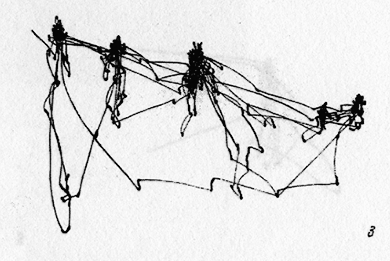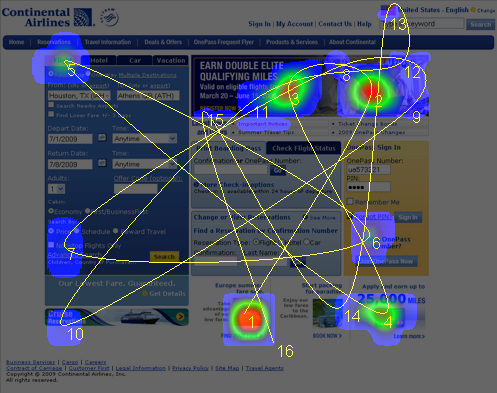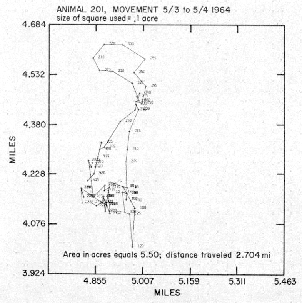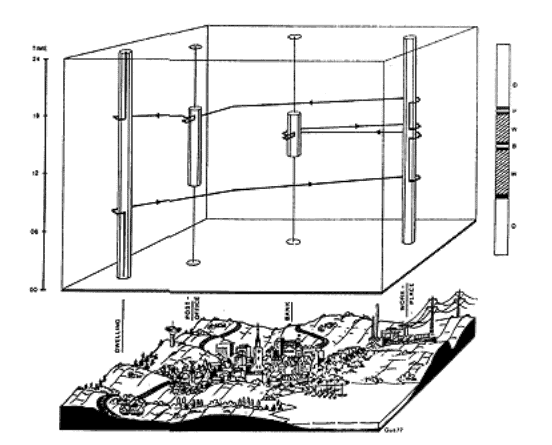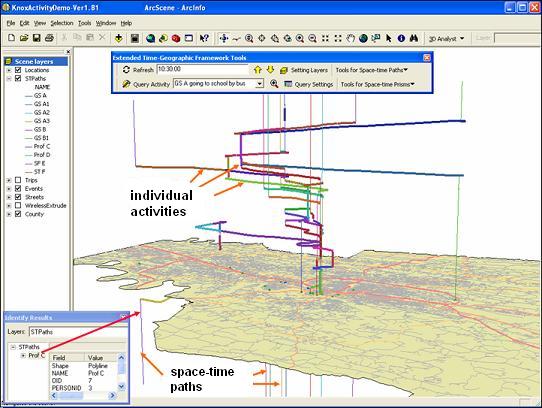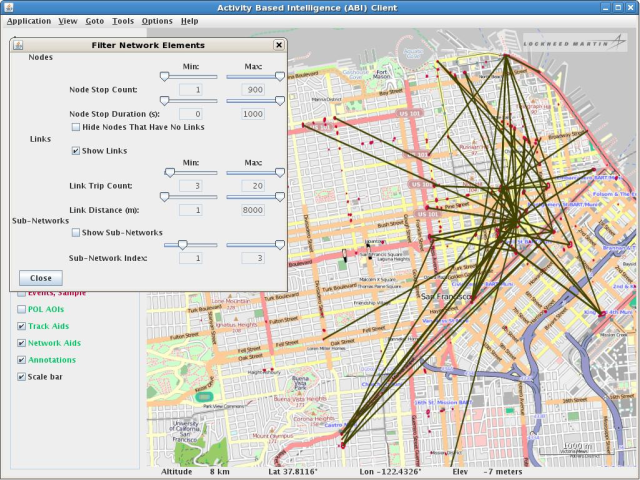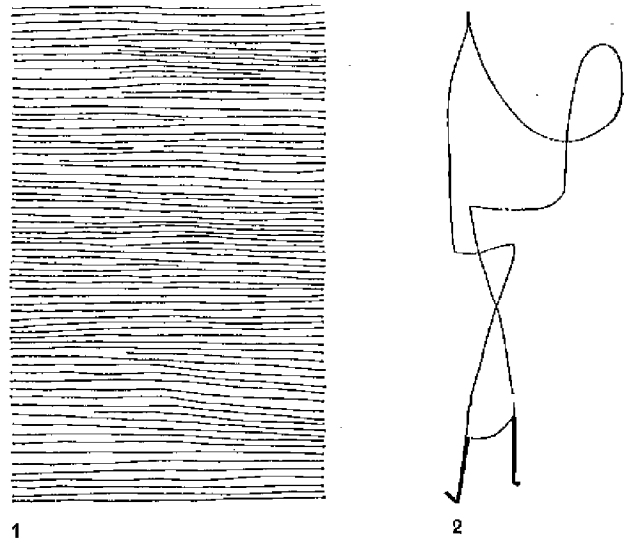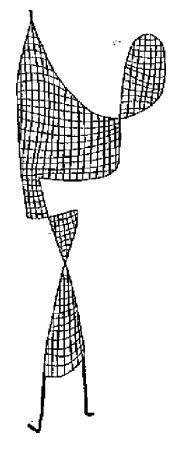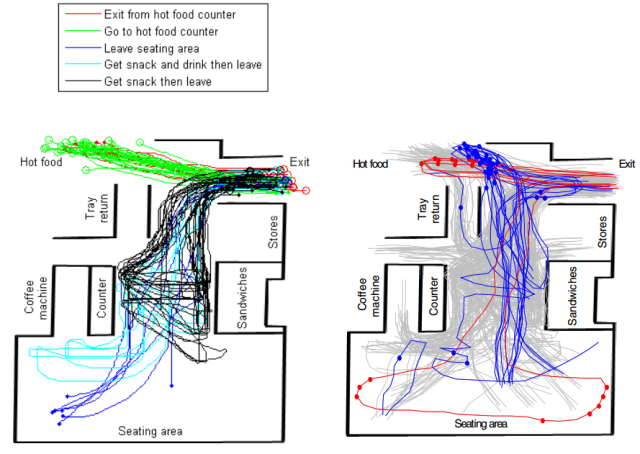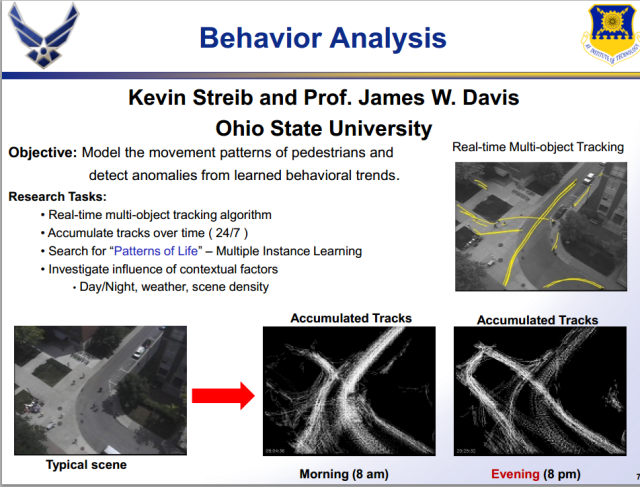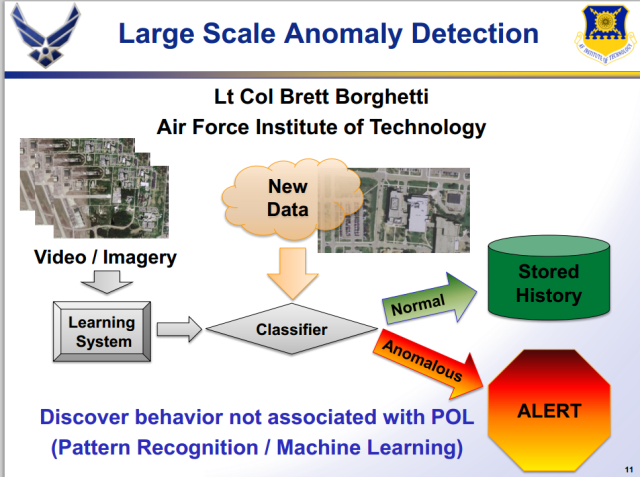Καθώς αναφέρεται η έννοια του διευρυμένου, εδώ ένα άρθρο +abstract του Lev Manovich [2002] The Poetics of Augmented Space:
[...]
This essay will discuss how the general dynamic between spatial form and information which has been with us for a long time and which I outlined above functions differently in computer culture of today. Since the kinds of environments I offered, as examples above do not have a recognizable name yet, I will give me a new name - an augmented space. The term will be explained in more detail below, but here is the brief definition: augmented space is the physical space overlaid with dynamically changing information. This information is likely to be in multimedia form and it is often localized for each user.
[...]
The space that symbolizes the Information Age is
not the symmetrical and ornamental space of traditional architecture, the rectangular volumes of
modernism, nor the broken and blown up volumes of deconstruction.Rather, it is space whose
shapes are inherently mutable and whose soft contours act as a metaphor for the key quality of
computer-driven representations and systems: variability.
[...]
Wednesday, April 29, 2015
Patterns of life: A Short history of Schematic bodies by G. Chamayou
Αντιγραφή από εδώ : Τhe very act of cartographying can never be politically neutral, since it produces a knowledge about a subject, and thus a relationship of power between the cartographer and this same subject.
“Patterns of Life: A Very Short History of Schematic Bodies,” is an illustrated essay about bodies’ movement traceability, using Michel Foucault’s historical and philosophical method of genealogy.
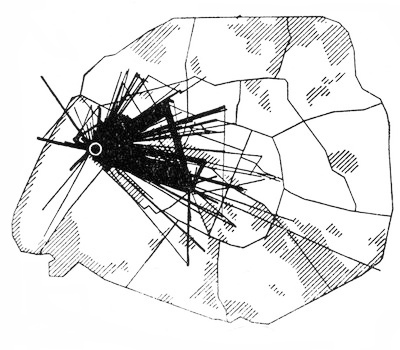
Routes taken during one year by a female student living in the 16th arrondissement of Paris / Paul Henry Chombart de Lauwe, 1952[2]
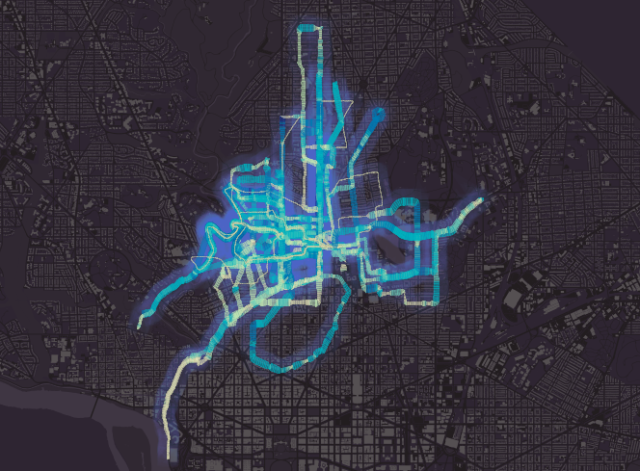
Data visualization of the running routes and the heart rate of Tom MacWright. The pulse acceleration is represented by the intensity variations of the blue color [29]

Neighborhood near Al Mahmudiyah, Iraq, where most transport is on foot. Simulated walking path were exploited to discover networks[37]
“Patterns of Life: A Very Short History of Schematic Bodies,” is an illustrated essay about bodies’ movement traceability, using Michel Foucault’s historical and philosophical method of genealogy.
1/// In his 1956’s Theory of the Dérive, Guy Debord described a Paris map drawn up by an urban sociologist depicting “all the movements made in the space of one year by a student living in the 16th Arrondissement”. “Her itinerary”, he remarked, “forms a small triangle with no significant deviations, the three apexes of which are the School of Political Sciences, her residence and that of her piano teacher.[1]”

Routes taken during one year by a female student living in the 16th arrondissement of Paris / Paul Henry Chombart de Lauwe, 1952[2]
The cartographic objectivation of a life form was taken as a starting point for a poetical and political critique of daily life. This was a critique of its narrowness, of its routines, of the reduction of the lifeworld they articulate. Debord concluded: “Such data — examples of a modern poetry capable of provoking sharp emotional reactions (in this particular case, outrage at the fact that anyone’s life can be so pathetically limited) (…) will undoubtedly prove useful in developingdérives (drifts).[3]”
2/// Today, San Francisco designers offer to sell strange jewels. They are small geometric medallions looking like spider webs or crystalline structures. Their patterns are actually those of your routes. Meshu, a new type of small silversmith business, uses the geolocation data collected by your smartphone in order to extract the schematic map of your peregrinations. The visualization of your chronospatial data generates a graph that may then serve as a model to carve out your personalized pendant in metal or wood.
The spatialized history of your travels therefore becomes a cryptic sign that you can wear as ornament. It is also a personalized emblem, the expression of a new art of portraiture.
3/// As cultural objects, these graphs may be compared to one of their precursors: the “silhouette portrait” developed at the end of the 18th century. With Johann Kaspar Lavater’s invention of a “sure and convenient machine for drawing silhouette,” such portraits became popular objects, a trend that carried new aesthetic codes for the presentation of oneself, but also new supports for an anthropological knowledge that claimed to decipher personalities by the study of the contours of one’s head.
The chronospatial profile has in common with the old skiagraphic [6] profile the multiplicity of its usages. The difference is, of course, that the trace turns away from the body’s morphological contour to focus instead on the imaginary lines of its movements. The profile must henceforth be understood in a metaphorical sense: it no longer refers to the static shape of a body, but to the dynamic form of its trajectories.[7] This is the kind of schematic bodies that forms the topic of my investigation.
4/// Since the 19th century, paleontologists have drawn an enlightening distinction between body fossils and trace fossils: “when we mentioned prints, molds, counter-prints,” writes Alcide d’Orbigny in 1849, “we spoke only of organic trace fossils of solid parts of animals buried in the strata; but there are other fossils left by living bodies on not-yet-consolidated sediments, and those have less to do with these solid parts of bodies than with their vital and physiological habits. They are prints of animal steps, furrows, fluting, rolls left by the moving organs of walking and swimming animals.[8]” Edward Hitchcock named such fossils “ichnites.” In German they are also called “Lebenspurren”: traces of life or “fossil vestiges of life.”
While the molding of a dead body, prisoner of the clay, provides the replica of a solid with its volumes and its textures, a series of footprints found on the ground only provides an account of its movements. In the latter case, the print has not been simultaneous but successive. The trace of an activity is a precipitation of successive events in the simultaneity of a space, its durable solidification on the plane of an inscribing surface. It is the image of a spatialized duration.
5/// In 1790, Kant wrote: “Every form of the objects of sense […] is either figure or play. In the latter case it is either play of figures (in space, viz. pantomime and dancing), or the mere play of sensations (in time).” The form of a dance, or more generally of a perceived movement is not that of a thing, with its fixed contours (the shape of a vase). It is a “play of figures” that can only authentically appear in a double difference of space and time.
During the same era, choreographic notation systems were invented. In corresponding treatises, a dance took the aspect of undulated sentences written in a weird symbolic language. Within the space of the sheet, these sentences evolved under the chronological horizontal axis of the musical score. The layout of the play of forms was no longer a mere account, it had become ascript, which was only transcribing the activity so as to better conduct it in practice.
6/// In the 1910s, two disciples of Taylor, Lilian and Frank B. Gilbreth developed an apparatus they called “chronocyclegraph.” After having affixed small electrical bulbs on a worker’s hand, they would take long exposure photographs of him as he executed his task. Thus did they obtain the image of a “continuous path of a cycle of motions” appearing in white lines on the photographic emulsion.
“I believe”, explained an enthusiastic young engineer, “a good method of illustrating how a motion model helps one to visualize is to compare it with the wake left by an ocean liner.[12]” What the various techniques I am describing have in common is that each presents us with a means of capturing trails, or else of adding more or less long-lasting trail-effects to activities that do not necessarily generate them spontaneously.[13]
In this specific case, the task of extracting the trajectory is accomplished by photographic means, or more precisely by a chronophotography: by treating the light source as a “spatiotemporal ink,” chronophotographic processes “constitute trails, as Didi-Huberman would say, by allowing the mobile’s movement to appear by an extended presence in various points of the image, which thus take on the appearance of simultaneity.[14]”
The invisible is thus made visible. It is, however, equally true that this process of visualization achieves a concomitant operation of invisibilization or erasure. On the photograph, the worker’s body is blurred into a kind of halo in the background. The body literally disappears behind the lines of its gesture. From the evanescent body, only the bright fossil of its past movement remains.
Michel Foucault has shown that the discipline of the 18th and 19th centuries was mobilizing “a sort of anatomo-chronological schema of behavior.[15]” But this is no longer exactly the case here. If the schema is still in a sense chronological (and even chronospatial), it is no longer anatomical. From the living body of the worker, there remains “merely the orbit of the motion.[16]”
Orbit is an instructive metaphor: a shift, so to speak, from an anatomy to a micro-astronomy of the productive gesture, where the glow of the small light bulbs would have replaced the brightness of the stars, although for a quite different study.
These orbits must not only be visualized but also modeled, in order to better be transformed. If one analyzes the trajectories of the gestures, it is in order to simplify them, to rid them of their useless detours: it is the principle of “waste elimination.[17]” Modelization is a prelude to standardization: “through a comparison of graphs or models showing the paths of different operators doing the same kind of work, it is possible to deduce the most efficient method and to make this a standard.[18]” The method, etymologically, is the path to follow. The standard is the shortest path, the one most economical.[19]
The Gilbreths also sculpt these movement models in three dimensions with wire and use it “to teach the path of the motion” to operators. The worker’s gesture, reconstructed in a laboratory, re-enters the workshop in a modified form, this time as a conducting thread to which productive bodies must conform their dance.
7/// In the mid-1960s, a member of the USSR Academy of sciences, Alfred Yarbus, published a book that deeply renewed the study of sight.[20] For his experiments, he used a sophisticated machine, a bit like the device on which one puts his/her chin in an ophthalmologic office except, in this case, equipped with cameras. Having recorded the micro-movements of the eyes, he could retrace the fast course that a subject’s eyes unconsciously follow when looking at a painting. These drawings, with their jolts and their fixed points, look a lot like Gilbreth’s photographs. They are also maps of gestures, but of ocular gestures, where the object of visualization is nothing other than the very action of seeing. [21]
Nowadays, eye tracking technologies are mobilized by marketing research. In the age of the “attention economy”, the user’s vision is methodically scrutinized in order to better capture it. Eye tracking heatmaps are produced to conduct “usability tests” and to choose the most efficient “design route” for a given graphic design project.
This method of analysis applies to web page design, product packaging, but also to the very architecture of retail spaces. Nowadays, some stores couple the video feed of their surveillance camera to the phone signals picked up by their wifi network in order to retrace their clients’ movement.[24] Within the physical space of the store the client is an eye, but an eye with legs. Thanks to the collected behavioral data, the space can then be reorganized in order to optimize the capture of attention.
Despite the similarity between these graphs and Gilbreth’s, the relation of normativity here is not the same. The wage relationship is structured by a relation of constraint that fundamentally gives to the norm the aspect of a command (even if it is also implemented through other means). In the mercantile sphere, it is at once through more lateral measures that an activity scheme is prescribed to bodies. In that case, the strategy consists in redrawing the space of visibility in order to orient and magnetize the ocular and corporeal mobility according to pre-established navigation routes. This normativity proceeds according to tactics of capture through design.
8/// In the beginning of the 1960s, American ethologists began to use new radio transmitters in order to study the movements of wild animals. These devices, fixed on bodies of cotton tail rabbits or white-tailed deers, allowed their positions to be known and their itineraries to be retraceable.[26] To address the mass of data rapidly produced by such radio-tracking systems, the scientists designed a program capable of automatically converting this data into maps.
The rise of telemetric technologies also inspired other disciplines. In 1964, at Harvard, two behavioral psychologists, Ralph Schwitzgebel, and his twin brother, Robert, developed a “behavioral supervision system with a wrist-carried transceiver.” This device, tested on “young delinquents” foreshadowed the electronic bracelet later adopted by the penal system. It was their dream to replace the old techniques of incarceration by new control technologies operating in an open milieu. To this end, they imagined a small wearable device able to record and to transmit various behavioral data wirelessly, including the geographic position of the subject, as well as “his pulse, brain waves, consumption of alcohol, or other physiological facts.[28]” If this electronic snitch sensor detected a risky behavior, the individual could be located and, if necessary, subjected to a preemptive intervention.
But what also deeply motivated this invention had to do with a libido sciendi. Through the automated remote collection of behavioral data, the electronic bracelet would allow behavioral sciences to continuously access a mass of detailed information about daily life. Could not the psychologist imitate the ethologist, and have his own network of transponder necklaces placed on the bodies of human animals? This art of remote measurement of human behaviors was named anthropotelemetry.
The task of collecting behavioral data that was to be entrusted to special sensors is nowadays largely accomplished by individuals themselves, who self-document their own activity in a context of generalized traceability. Tom MacWright is a geographic information systems engineer. He is also an amateur runner. He recently created an application that allows him to visualize his running routes in the city, as well as his heartbeat fluctuations during effort.

Data visualization of the running routes and the heart rate of Tom MacWright. The pulse acceleration is represented by the intensity variations of the blue color [29]
This map illustrates an important principle: datafusion refers to data collected from heterogeneous sources that are fused to the same chronospatial schematic body. The only condition is that this information must have been referenced in advance according to spatiotemporal coordinates.
9/// Still in the 1960s, an innovative movement in human geography undertook to revolutionize its discipline: it was the project of chronogeography or time-geography. The fundamental idea was that one could give an account of human lives by treating them as paths within space-time. This implied, among other things, the invention of new kinds of maps, which would articulate time to space. Torsten Hägerstrand, one of the founding fathers of this methodology, summed up its postulate as follows: “In time-space the individual describes a path (…) the concept of life path (or path of it such as the day path, the week path, etc) can easily be shown graphically if we agree to collapse a three-dimensional space into a two-dimensional plain (…), and use a perpendicular direction to represent time.[30]”
The following illustration is a first instance of this kind of representation, still in a rudimentary state. A thread is wound around vertical sticks that have been hammered into a three-dimensional map representing the itinerary of an individual during a given period:
:
Nowadays, this kind of cartographic representation has been integrated into powerful geographical data systems used for geovisual analytics research.
As Mark Monmonier points out, this kind of object is fundamentally “mapping, rather than maps, because cartography is not limited to static maps printed on paper or displayed on computer screens. In the new cartographies of surveillance, the maps one looks at are less important than the spatial data systems that store and integrate facts about where we live and work.[33]“
The tools of chronogeography, conceived in the 1960s, had been mostly conceived as tools of urban and social planners, usually associated with reformist political agendas. Nowadays, much less benevolent functions are being increasingly assigned to them. The fundamental postulate of time-geography, according to which individual biographies can be tracked as “life paths in time-space” is in the process of becoming the epistemological basis of other sorts of practices of power.
10/// In 2010, the highest authorities in the U.S. Intelligence community laid down the principles of a new paradigm. It was the “Activity Based Intelligence” (ABI) doctrine, elaborated under the auspices of the NSA’s less famous sibling bureaucracy the National Geospatial Intelligence Agency (NGA). Theoreticians of intelligence describe this shift as the conversion to a new philosophy, a new method of knowledge.
Derek Gregory describes it insightfully as “a sort of militarized rhythmanalysis, even a weaponized time-geography” based on the use of programs “that fuse and visualize geospatial, temporal and intelligence data from multiple sources (‘combining the where, the when and the who’) as a three-dimensional array that replicates the standard time-geography diagrams developed by Swedish geographer Torsten Hägerstrand in the 1960s and 1970s.[34]” As Gregory concludes, it consists in “tracking multiple individuals through different social networks to establish a ‘pattern of life’ consistent with the paradigm of activity-based intelligence that forms the core of contemporary counterinsurgency.[35]“
This methodology is based on, among other things, the use of data mining applied to trajectories of movements in order to discover, within gigantic assortments of paths, periodic patterns or signatures corresponding to characteristic segments of habits. Beyond tracking singular itineraries, the goal here is to progressively extract typical schemas of activity. Regular routes progressively thicken on the screen, like paths frequently taken by a flock dig their furrows in the grass of a field.
The following figure is a map produced by an Activity Based Intelligence module conceived by Lockheed Martin engineers and tested on cab trips in an American city:
What works with taxi trips can, of course, be applied on other objects, as, for example, pedestrian routes in an Iraqi village monitored by the camera of a drone :

Neighborhood near Al Mahmudiyah, Iraq, where most transport is on foot. Simulated walking path were exploited to discover networks[37]
11/// Originally, chronogeography was born out of a refusal of the predominance of statistical methods in social sciences. If we describe social reality mainly through aggregates of large numbers, such as those given by a census, “we regard the population as made up of ‘dividuals’ instead of individuals,” regretted Hägerstrand.[38]
Statistical aggregates, such as GDP or income groups, do not provide us with access to a primary knowledge about concrete individuals, but only, in an indirect way, to statistical beings that are reconstructed as fractions of a global number.
Chronogeography, on the contrary, claimed to represent individuals as they exist in a continuous fashion, as physical points affected by spatiotemporal trajectories. The conviction was that, between the work of the biographer and that of the statistician, “there is a twilight zone to be explored, an area where the fundamental notion is that people retain their identity over time (…) and where aggregate behavior cannot escape these facts.[39]” In other words, as Nigel Thrift put it, chronogeography starts from the methodological premise of the “indivisibility of the human being.[40]” What was then proposed to social science was to rebuild aggregates of data starting from the undividable granularity of the individuals, whose “lived corporeality” could then be schematically represented through traceable and measurable paths in space-time.
It is striking that, in order to express this idea, Hägerstrand used the very same vocabulary that Gilles Deleuze would mobilize twenty years later to define what he called “societies of control”: “We no longer find ourselves dealing with the mass/individual pair. Individuals have become ‘dividuals,’ and masses, samples, data, markets, or ‘banks.[41]’” On the one hand, there were disciplinary societies structured around a relationship between the individual and the mass, on the other hand, societies of control articulated through the dyad of “dividuals” and databanks. On the one hand, institutions of confinement, on the other hand, processes of control operating in open milieus. On the one hand, signatures and administrative numeration taken as the landmarks of individuality, on the other hand, codes and passwords as conditions of access.
Hägerstrand and Deleuze borrowed this conceptual distinction between individuality and dividuality from some reflections on form that the painter Paul Klee developed during the interwar years. According to his view, this pair of notions could be schematized as follows:
The individual is illustrated by a linear figure, a shape of a body in motion (figure 2). It is defined negatively as something from which nothing can be cut off without destroying the whole, without rendering it unrecognizable. In that sense, the individual is first something indivisible: to divide it would be to mutilate it, to destroy its constitutive organic unity. The dividual, on the contrary, is defined by its divisibility. Divide or carve up the lines in figure 1, cut off one or some of them, and the pattern will still not disappear. It will remain despite its partition. This is, in brief, the difference between the pattern of a tapestry, whose rhythms are repetitive, and the drawing of the organic form of a body.
Beginning in the 1970’s, Hägerstrand made it a prescription of method that we shift from (1) to (2) – namely to replace, as the basic element of knowledge, statistical dividuality by chronospatial individuality.
In turn, what Deleuze says at the end of the 1990’s—but this time as an historical and political diagnosis—is that we are shifting from (2) to (1), i.e., that ancient machineries of power centered on individuality were in part being replaced by new ones, whose object would be the “dividual”.
For now, our question is the following: what happens to Deleuze’s prognostic when the basic postulate of chronogeography, mainly, the lashing of an aggregation of data to individually indexed chronospatial paths, becomes so prevalent as to serve as the effective operational basis for an entire series of practices of power?
What we then obtain is, at first glance, something different from the dividual; on the contrary, we find chrono-geographical individualities considered both as objects of knowledge and of intervention. As Derek Gregory has shown, the contemporary uses of various electronic means of identifying, tracking, and locating targets amounts in fact to an operation of “technical production of ‘individuals’ as artifacts and algorithms.[43]” If this surely entails a certain mode of individuation, the question would then be to characterize it conceptually. Yet, one of the difficulties to do so is that it hardly fits the category of disciplinary individualization recalled by Deleuze in his ‘Postscript’.
The technologies in question certainly focus on the search for “signatures” – that is, according to the philosopher, one of the favorite signs in the political semiotics of the discipline – but they also spread out today in open milieus like the apparatuses of control. They focus on individualities conceived as indivisible chronospatial units, but, to constitute them, they also mobilize dividual material, aggregated in databases and treated in an algorithmic fashion. This double set of traits makes them a poor fit in Deleuze’s framework. They correspond neither to the individualization of discipline, nor to the “dividualization” of control.
In order to grasp what we are dealing with here, I think that we could refer to a third figure, also to be found in Klee’s work :
Dividual and individual are not necessarily in opposition, they can also be combined. This third figure illustrates a case of “dividual-individual synthesis.[45]” Such a synthesis happens when “certain activities produce very definite structural forms which can observably become individuals,[46]” that is to say, when “the structural characters are rhythmically joined into an individual whole.[47]” The undulated dividual thread, in which has been cut in the linear individual figure that also delineates its external contour, then appears as a “dancing grid”.
The corresponding object of power here is neither the individual taken as an element in a mass, nor the dividual appearing with a code in a databank, but something else: a patterned individuality that is woven out of statistical dividualities and cut out onto a thread of reticular activities, against which it progressively silhouettes in time as a distinctive perceptible unit in the eyes of the machine.
The production of this form of individuality belongs neither to discipline nor to control, but to something else: to targeting in its most contemporary procedures, whose formal features are shared today among fields as diverse as policing, military reconnaissance and marketing. It might well be, for that matter, that we are entering targeted societies.
12/// For the military promoters of these methodologies, the initial hope was, according to an Intelligence, Surveillance and Reconnaissance (ISR) methodology inherited from the Cold War, to be able to model behavioral “signatures” associated with “terrorist” patterns of life. But this ambition faces at least one fundamental epistemological problem. In a context marked by “a scarcity of meaningful data and a low signal to noise ratio, i.e., [where] the ‘bad’ element look[s] and act[s] much the same way as the ‘good’ elements,” one cannot obtain non-ambiguous patterns of life allowing a positive identification.[48]
Intelligence specialists are aware of this difficulty. Today, they portray the Activity Based Intelligence paradigm as an attempt to overcome this obstacle. This methodology, they insist, is “focused on understanding entities that don’t have signatures in any single sensor phenomenology. [49]”
In the “discourses on method” that they write, the problem takes on almost metaphysical formulations. The mystery is the following: how to discover “unknown unknowns?[50]” An unknown known is an individual whose singular identity is unknown, but whose perceptible attributes correspond to a known type. An unknown unknown is one that slips out of both a singular identification and a generic one: it is not known who he is (ignorance of his name or his face), nor what he is (his activity profile does not correspond to the inventoried ones).
The solution envisioned then is, in a certain way, already contained in the terms of the question: in order to spot unknown forms, one has logically to already possess an inventory of known forms. The idea is thus to identify the typical in order to spot the atypical. One has to develop “patterns of life to identify which activities are normal and which are abnormal.[51]”
Within such a model, by “accumulat[ing] tracks over time,” one can, for example, “model the movement patterns of pedestrians and detect anomalies from learned behavioral trends. [52]” For example, once the “normal” itineraries of someone carrying a meal tray in a canteen have been identified, one can by contrast see the emergence of a certain amount of aberrant trajectories.
Beyond those kinds of test studies conducted in closed space, the goal is to deploy these methodologies of behavioral sorting within “large-scale anomaly detection” programs::
The rationality that orders such a detection work relies on a normative divide, a certain conception of what is normality. But, from a philosophical standpoint, one has to note that the notion of normal patterns or forms of life is not based here, unlike for instance in the discourse of transcendent morals, on any particular “must be” or normative imperative. These are, in a sense,normativities without norm. Their notion of the normal is, in fact, strictly empirical: it is learned by the machine on the basis of an analysis of frequencies and repetitions in given sets of activities. It is then a discrepancy with such patterns of regularities – an anomaly, rather than anabnormality – that will trigger the red-orange alert on the analyst’s screen.
But one of the classical issues with such a conception of normality is that, as Georges Canguilhem explained, “we would necessarily have to treat as abnormal (that is to say, we believe, pathological) every abnomal individual, every carrier of anomalies – every individual aberrant in relation to a specific, statistically defined type.[55]” While a singular discrepancy can be interpreted in various ways, for instance “as a failure or as an attempt, as a fault or as an adventure,” a paranoid apparatus immediately tends to flag it as potential threat[56]: “ALERT.”
In a rather ironic way, it is within the very societies whose dominant ideology held sacred the individual freedom to follow one’s own way of life that the singularity of such a route soon ends up being automatically signaled as suspicious. It should be noted, however, that this is not due, in this case, to the predominance of a logic of standardization or uniformization. By using these chronospatial patterns to filter behaviors, these devices have no particular model trajectory they seek to impose on the various lives they monitor. Their normativity without norm is animated by another goal, another kind of devouring appetite: to spot discrepancies in order to “acquire targets,” and this in a mode of thought where, targets being unknown, it is the unknown that becomes targeted. Another way to put it is that, in such regimes of knowledge and power, a potential target appears fundamentally as a drift [une dérive].
NOTES ///
[1] Guy Debord, « Theory of the dérive », The Situationist International Anthology, ed. Ken Knabb, Bureau of Public Secrets, Berkeley, 1981, p. 50.
[2] Paul Henry Chombart de Lauwe, Paris et l’agglomération parisienne, Volume 1, Presses universitaires de France, Paris, 1952, p. 106.
[3] Debord, op. cit.
[5] Johann Caspar Lavater, L’art de connaitre les hommes par la physionomie, Prudhomme, Paris, 1806 (frontispice).
[6] Greek term for the art of shadow drawing/writing.
[7] This of course doesn’t mean that the logic of biometric identification would disappear, in order to be replaced by this other mode of representation – far from it.
[8] Alcide d’ Orbigny, Cours élémentaire de paléontologie et de géologie stratigraphiques, Premier volume, Masson, Paris, 1849, p. 27.
[9] Edward Hitchcock, Elementary Geology, New York, Ivison and Phinney, 1855, p. 187.
[10] Kellom Tomlinson: The art of dancing explained by reading and figures (1735) Cf.http://earlydance.org/content/6477-minuet
[11] Photograph from National Museum of American History, Behring Center, Division of Work and Industry Collection.
[12] Gilbreth, Op. cit., p. 207
[13] cf. Georges Didi-Huberman, Phalènes, Éditions de Minuit, Paris 2013.
[14] Caroline Chik, L’image paradoxale, Fixité et mouvement, Presses Universitaires du Septentrion, Villeneuve d’Ascq, 2011, p. 90.
[15] Michel Foucault, Discipline and Punish: The Birth of the Prison, New York: Vintage Books, 1995.
[16] Gilbreth, Op. cit., p. 46.
[17] Idem, p. 130.
[18] Ibid., p. 91.
[19] “The standard is not only the best gesture itinerary in terms of productivity for a given activity, but also a transferable norm. By consulting a kind of general inventory of efficient gestures, one could, in a proto-benchmarking logic, export “from one trade, craft or profession to another” the most economical gesture segments.” Ibid. p. 92
[20]Alfred Yarbus, Eye Movements and vision, Plenum press, New York, 1967.
[21] In this regard, see the work of the artist Julien Prévieux, « Esthétique des statistiques » in Isabelle Bruno, Emmanuel Didier, Julien Prévieux (dir.), Statactivisme: Comment lutter avec des nombres, Zones/La Découverte, Paris, 2014, http://www.previeux.net/html/textes/statact.html
[22] Yarbus, Op. cit., p. 174.
[23] http://blog.normalmodes.com/blog/2009/09/28/eye-tracking-heatmap-gallery-a-preview-discussion-of-ui-considerations
[24] See Stephanie Clifford, Quentin Hardy, “Big Data Hits Real Life”, New York Times, July 14, 2013. http://www.nytimes.com/2013/07/15/business/attention-shopper-stores-are-tracking-your-cell.html?pagewanted=all&_r=0
[25] Screenshot from the video “Big Data Hits Real Life” by Erica Berenstein, New York Times, Jul. 14, 2013 : http://www.nytimes.com/video/business/100000002206849/big-data-hits-real-life.html
[26] See for example John R. Tester, Dwain W. Warner and William W. Cochran, “A Radio-Tracking System for Studying Movements of Deer” in The Journal of Wildlife Management Vol. 28, No. 1 (Jan., 1964), pp. 42-45.
[27] Donald B. Siniff and John R. Tester, “Biotelemetry”, BioScience, Vol. 15, No. 2, (Feb., 1965), pp. 104-108, p. 107.
[28] “Anthropotelemetry: Dr. Schwitzgebel’s Machine”, Harvard Law Review, Vol. 80, No. 2 (Dec., 1966), pp. 403-421, p. 409.
[30] Torsten Hägerstrand, (“What about people in regional science?”. Papers of the Regional Science Association, Volume 24 (1), 1970, pp. 6–21, p. 10.
[31] B. Lenntorp, “A Time-Geographic Simulation Model of Individual Activity Programmes “, in T. Carlstein, D. Parkes and N. Thrift (Eds.), Human activity and time geography, London, Edward Arnold, 1978, pp. 162-180.
[32] Screenshot of chronospatial graph obtained through the visualization module3D ArcScene of the software ArcGIS by ESRI : http://web.utk.edu/~sshaw/NSF-Project-Website/pages/activities.htm
[33] Mark Monmonier, Spying with Maps: Surveillance Technologies and the Future of Privacy , University of Chicago Press, Chicago, 2004, p. 1.
[34] Derek Gregory, “Lines of descent”, Open democracy, 8 novembre 2011,http://www.opendemocracy.net/derek-gregory/lines-of-descent
[35] Derek Gregory, ‘From a view to a kill: drones and late modern war’, Theory, culture and society, 28 (6) (2011), pp. 188-215, p. 195 and 208.
[36] Ray Rimey,Jim Record, Dan Keefe, Levi Kennedy, Chris Cramer, “Network Exploitation Using WAMI Tracks”, Defense Transformation and Net-Centric Systems 27-28 April 2011, Orlando.
[37] idem
[38] Hägertsrand, Op. cit., p. 9.
[39] Idem., p. 9
[40] Nigel Thrift, An introduction to time geography, Institute of British geographers, London, 1977, p. 6.
[41] Gilles Deleuze, « Postscript on the Societies of Control, » in journal OCTOBER 59, Winter 1992, MIT Press, Cambridge, 3-7.
[42] “Formal analysis of 1935/3 : Grid dance”, Paul Klee, Notebooks, Volume 2, The nature of nature, Lund Humphries, London, 1973, p. 284. (These explanatory figures have in fact been compiled by the editor of the volume, Jürg Spiller)
[44] Klee, op. cit., p. 285.
[45] Idem, p. 63.
[46] Idid., p. 247.
[47] Idid., p. 234.
[48] See also Jeff Jonas and Jim Harper, Effective Counterterrorism and the Limited Role of Predictive Data Mining, Policy Analysis, Cato Institute, December 11, 2006.http://www.cato.org/sites/cato.org/files/pubs/pdf/pa584.pdf#584
[49] Mark Phillips, “A brief overview of ABI and Human Domain Analytics”, Trajectory Magazine, 2012. http://trajectorymagazine.com/web-exclusives/item/1369-human-domain-analytics.html
[50] Idem.
[51] “From data to decisions III”, IBM Center for the Business of Government, November 2013, p. 32. http://www.govexec.com/media/gbc/docs/pdfs_edit/111213cc1.pdf
[52] Kevin Streib, Matt Nedrich, Karthik Sankaranarayanan James W. Davis “Interactive Visualization and Behavior Analysis for Video Surveillance”, SIAM Data Mining International Conference on datamining, Columbus, Ohio, 2010.
[53] Richard.O. Lane, Keith.D. Copsey, Conference Paper “Track anomaly detection with rhythm of life and bulk activity modeling”, Information Fusion (FUSION), 2012 15th International Conference.
[54] Brett Borghetti, Anomaly Detection Through Behavior Signatures ISRCS Briefing 10 Aug 2010.
[55] Georges Canguilhem, Knowledge of Life, Fordham university Press, New York, 2008, p. 127
[56] Idem., p. 125.
Subscribe to:
Posts (Atom)
